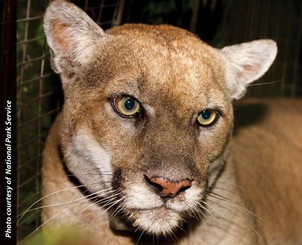
Final Necropsy Findings For P-22
Wednesday June 14, 2023
(Top photo courtesy NPS)
(Bottom photo by Steve Winter of P-22 in front of Hollywood Sign)

Update--The California Department of Fish and Wildlife and the National Park Service say that the final necropsy supports the decision to euthanize the world famous mountain lion P-22.
P-22 was captured last December after reports that the mountain lion was acting strangely and was unusually aggressive including two attacks on leased dogs being walked by their owners.
A follow up and final necropsy just released confirmed that P-22 was "suffering from multiple severe injuries and chronic conditions that impaired his ability to function in the wild and would have lowered his quality of life if placed in human care."
What they found was irreversible kidney disease and life threatening injuries to his head, right eye, and internal organs suffered after he was likely stuck by a vehicle, injuries that would have required extensive surgeries.
P-22 was also suffering from a host parasitic skin infections over his entire body caused by mange and a fungus.
However, while he had been exposed to five anticoagulant rodenticide compounds there was no evidence of AR poisoning.
The big cat had roamed the Santa Monica Mountains around Griffith Park, including the populated hillside areas near the Hollywood sign.
In fact, an iconic photo of P-22 by photographer Steve Winter for National Geographic showing the mountain with the Hollywood sign in the background was world famous.
***************************
Here is the latest, updated, news release regarding P-22...
June 14, 2023
Final necropsy results released for mountain lion P-22
The California Department of Fish and Wildlife (CDFW) and National Park Service (NPS) reviewed the final postmortem examination and lab tests from P-22, the mountain lion from Griffith Park. The results confirmed P-22 had been suffering from multiple severe injuries and chronic conditions that impaired his ability to function in the wild and would have lowered his quality of life if placed in human care.
P-22 was captured and anesthetized by CDFW and NPS on December 12, 2022, after scientists noted a recent change in his behavior.
He was transported to the Los Angeles Zoo for initial examination and treatment, then transferred to the San Diego Zoo Safari Park for follow-up evaluation, including a computed tomography (CT) scan, where it was discovered that he had serious injuries and health problems. He was euthanized under general anesthesia on December 17, 2022.
The postmortem examination was completed by veterinary pathologists at the San Diego Zoo.
"We are grateful to the San Diego Zoo Safari Park and Los Angeles Zoo teams," said Deana Clifford, a senior wildlife veterinarian for CDFW. "They provided excellent care for P-22 and conducted a detailed postmortem examination that shed plenty of light on this cat's condition."
Some findings demonstrated that P-22 had recent trauma to his head and right eye, including an orbital fracture with bleeding and early stages of scar tissue development. This is consistent with reports of a vehicle strike the night before he was captured.
P-22 also had injuries consistent with older, significant trauma, including a diaphragmatic rupture, through which the liver and sections of connective tissue from the abdomen had herniated and were inside his chest cavity.
Pathologists determined that this injury was older than the injury to his face and eye due to differences in the stages of scarification associated with each injury.
The examination also confirmed that he was underweight, arthritic and had progressive and incurable kidney disease, as determined before his death. He also had a severe parasitic skin infection over his entire body, caused by demodectic mange and a fungus, specifically ringworm. This is the first documentation of a demodectic mange infection and a concurrent systemic ringworm infection in a California mountain lion.
Toxicology testing on his liver at the California Animal Health and Food Safety Laboratory (CAHFS) UC Davis revealed exposure to five anticoagulant rodenticides (AR) compounds. However, he had no evidence of AR poisoning (i.e., unexplained bleeding, injury, illness or death due to exposure to the toxicants).
These include first-generation ARs, diphacinone and chlorophacinone, and longer-lasting and faster-acting second-generation ARs, brodifacoum, bromadiolone and difethialone. Diphacinone was also detected in a sample of P-22's blood collected after he was captured, which may indicate recent exposure. Diphacinone was also detected in P-22's blood in 2014 when he was captured by NPS biologists and treated for a different skin infection caused by notoedric mange.
A separate CDFW study tested 247 mountain lions at the CAHFS lab. It showed that 96 percent of tested animals had exposure to one or more ARs. While felids tend to be more resistant to AR poisoning, there have been at least seven AR-related mortalities in Southern California mountain lions over the last 19 years.
Additionally, desmethylbromethalin, the toxic metabolite of bromethalin, was detected in his body fat. Bromethalin is a widely available rodenticide that targets the brain and affects the central nervous system. Signs of bromethalin poisoning include muscle tremors, seizures, hind limb paralysis, respiratory paralysis and eventually death. There was no indication that bromethalin exposure resulted in poisoning on P-22’s medical or pathologic exam. How P-22 was exposed to bromethalin, directly or secondarily through prey, is unknown. However, it is believed to be the latter.
P-22 was likely born in the Santa Monica Mountains as the son of adult male P-1. NPS biologists first captured and radio-collared P-22 in March 2012 when he was estimated to be two years old. He was one of the most senior mountain lions in a study the NPS has conducted since 2002.
He persisted for more than 10 years in Griffith Park in the smallest home range that has ever been recorded for an adult male mountain lion. But life on this tiny “island” did not come without consequence. After crossing two of the busiest freeways in the world, 101 and 405, he would unknowingly become isolated and never produce offspring.
His movements and access to natural habitat and prey would be restricted, putting him at increased risk for interactions with people, collisions with cars and exposure to rodenticides. As extraordinary as P-22’s life was - surviving against all odds - it is an increasingly common reality for wildlife.
"P-22 was a fascinating animal to study," said Jeff Sikich, the lead field biologist of the NPS mountain lion study. "Not only was he an important ambassador for urban wildlife, but his scientific contributions were also many. He helped us understand how mountain lions coexist with humans in this complex urban landscape, and his legacy will live on through our heightened awareness of how to live in harmony with wild neighbors and growing public support for wildlife crossings."
NPS has been studying mountain lions in and around the Santa Monica Mountains for the last two decades to determine how they survive in a fragmented and urbanized environment. CDFW is responsible for overseeing the management and conservation of mountain lions in the state.
For more information about P-22’s life and legacy, visit the NPS puma profiles.
Learn more about CDFW’s efforts to improve wildlife connectivity and to educate Californians about living with wildlife.


